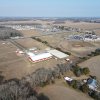Sussex County Airport opens new crosswind runway
With the squeal of tires touching down and a puff of white smoke, Sussex County Airport’s newest runway is ready for takeoff.
|
Sussex County Airport
|
|
• Project reconstructed Runway 10-28 as the airport’s crosswind runway to provide pilots another option for landing when strong winds are blowing perpendicular to the airport’s main runway
• Replaces Runway 13-31, which was closed and is now part of the airport’s taxiway system • Runway 10-28 was built in 1943 as one of three runways at the airport, then used by the Navy; it closed in the early 1970s • Runway 10-28’s original length was 5,000 feet • New crosswind runway dimensions are 3,109 feet long and 75 feet wide • Two new 50-foot-wide connecting taxiways also constructed to join Runway 10-28 with the airport’s main runway • Runway 10-28 is composed of 3-inch-thick hot-mix asphalt atop a 16-inch subbase composed of processed, recycled concrete from old Runway 10-28, providing significant savings on material • The project was constructed in two phases: Phase I was the demolition of existing Runway 10-28 and adjoining taxiways, and Phase II was or constructing the new Runway 10-28 and associated taxiways • The total estimated cost was $5,573,974; the Federal Aviation Administration paid $5,061,374, Delaware paid $133,194, and Sussex County paid $379,406 • The consulting engineering firm was Delta Airport Consultants, deltaairport.com • The primary contractor was Dixie Construction, dixieconst.com |
County officials, joined by various local and state dignitaries, officially opened a new crosswind landing strip, known as Runway 10-28, during a ceremonial aircraft landing and ribbon-cutting ceremony Tuesday, Aug. 25, at the Sussex County Airport near Georgetown.
Construction of the nearly $5.5 million project ended last week after almost three years of work to demolish an abandoned runway and rebuild it for use. The rebuilt runway will serve as a secondary airstrip at the airport, giving pilots an additional landing and takeoff option when crosswinds, which run perpendicular to a plane’s flight path, prevent use of the main runway.
The new crosswind runway replaces a smaller alternate strip, Runway 13-31, which has since been closed and is now part of the airport’s taxiway system.
“This new, longer crosswind runway gives us an increased level of safety, as well as increased capability for the airport,” airport Manager Jim Hickin said.
“This makes Sussex County Airport more attractive as a general aviation field, because the added runway offers pilots another choice, and it means that we can now accommodate larger, private aircraft that may not have been able to use our former crosswind runway.”
“Pilots will be thrilled to have this,” said Hickin, “and they’ll love that new runway smell.”
Last used by aircraft in the 1970s, Runway 10-28 was one of three originally built at the airport in 1943. Of the three original runways - all 5,000 feet long - one remains today as the airport’s main runway; another was converted decades ago into the county’s industrial park.
Since being abandoned, Runway 10-28 had fallen into disrepair and most recently, in the 1990s, was used as a parking lot for former military cargo planes. County officials and engineers, as part of an overall airport improvement plan, reconfigured Runway 10-28 into a new crosswind runway to give pilots a longer, wider secondary runway when using the airport.
Construction on the project began in late 2006, with the demolition of the old Runway 10-28. Its concrete surface was recycled and used as the foundation layer for the new crosswind runway. Crews then laid a 3-inch-thick asphalt surface to complete the airstrip, which officially measures 3,109 feet long and 75 feet wide.
Also included in the project was the construction of adjoining taxiways, including the conversion of the former crosswind runway nearby, to connect the airstrip to the airport’s 5,000-foot-long main runway and other parts of the complex. More than 90 percent of funding for the project is coming through the Federal Aviation Administration, with the Sussex County Council contributing $379,406 and the state of Delaware funding the rest.
County Council President Vance C. Phillips, who helped christen the new runway as a passenger aboard the first plane to land there, said the airport is a key component to the county’s transportation infrastructure and integral to Sussex’s economic development efforts.
“This airport is a gateway to commerce, to business and to recreation in Sussex County,” said Phillips. “Without improvements such as this, Sussex County runs the risk of being passed over by countless visitors and new business opportunities.”
The Sussex County Airport, owned and managed by the Sussex County government, is a general aviation field that records nearly 50,000 landings and takeoffs annually and is popular with a mix of small private and large commercial-type aircraft.






















































